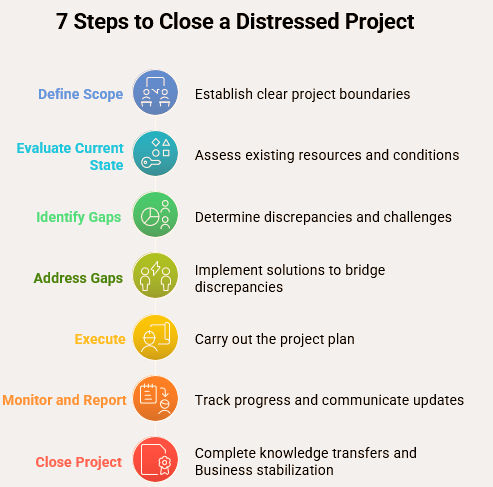Turning the Tide Pt. 5: Closing a Project & Recap of the Series
- Justin M
- Jul 14
- 4 min read

You’ve done the heavy lifting, triaged the chaos, rebuilt momentum, and delivered progress under pressure. But without a strong close, all that work can quickly unravel.
Closure isn’t a checkbox. It’s your final chance to validate that the intended business value was delivered, transfer ownership with confidence, and ensure the organization can operate without you.
In this final installment, we focus on the essential transition from recovery to lasting resilience, ensuring successful adoption and seamless business operational continuity. Finishing strong is not optional; it determines whether a project delivers real value and becomes fully embedded or simply fades without impact.
Step 7. Close Project
Closure is where you shift from driving progress to ensuring continuity. At this stage, your role is less about momentum and more about readiness, making sure the business is equipped to move forward without disruption. It’s also your moment to instill confidence that what’s been delivered is not only complete but also sustainable.
Here’s what effective closure looks like:
✅ Secure final validations: Get formal confirmation from the business that the solution is working as expected in production. Validate system behavior, confirm business process execution, and ensure integrations and reporting are accurate. This isn’t just due diligence; it’s your assurance that the business can run smoothly post-handoff. Capture sign-offs from the decision-makers as well.
📂 Finalize documentation: Document everything the support team needs: final requirements, design artifacts, test results, sign-offs, training materials, and process guides. Poor documentation leads to confusion, rework, and knowledge loss. Store everything in a centralized location and verify access.
🔄 Transfer knowledge: A successful handoff is more than a meeting; it’s structured knowledge transfer. Hold walkthroughs and Q&A sessions so the support team understands both how the solution works and why certain decisions were made. Clarify open items, recurring tasks, and known workarounds so nothing falls through the cracks.
🧠 Conduct retrospectives: Before closing the project completely, lead a candid retrospective with key stakeholders and the project team. Reflect on what went well, what didn’t, and where improvements can be made. Capture leading practices and opportunities for improvement through lessons learned to inform future projects and enhance organizational capabilities.
💡PRO TIP: The only way to close a project successfully is to ensure the intended business has been attained and the business stakeholders can operate without your future intervention.
The Path from Crisis to Value: A Recap of the Seven Essential Steps
Distressed projects demand more than firefighting; they require a pragmatic and intentional approach with consistent follow-through.
Here's a high-level recap of the seven steps to take when trying to close a distressed project:
Step 1. Define Scope 🎯 Clarify what the project is and isn’t intended to deliver. Align with stakeholders early, and formalize scope and success criteria. This becomes your anchor for every decision that follows.
Step 2. Evaluate the Current State 🔍 Rapidly assess the project across all dimensions: strategy, governance, planning, communication, solution, and morale. Identify active blockers and where the project is leaking time, trust, or value.
Step 3. Identify Gaps 🛠️ Pinpoint what's broken, missing, or unclear. From outdated plans to unowned risks, shadow friction, or morale breakdowns, prioritize the gaps that threaten stability and momentum.
Step 4. Address Gaps 🚧 Take focused, intentional action. Update plans, reinforce governance, clarify ownership, and re-engage stakeholders. Don’t try to fix everything; start with what matters most to regain traction.
Step 5. Execute 📈 Drive progress amid complexity. Balance competing demands, manage stakeholder noise, and maintain clear priorities. Execution is where your leadership becomes visible and tested.
Step 6. Monitor & Report 🗂️ Communicate with purpose, not just frequency. Use a mix of tactical and executive-level reporting to maintain transparency, manage risk, and keep alignment intact.
Step 7. Close Project ✅ Confirm that the intended business value was realized. Finalize documentation, hand off ownership confidently, and ensure the organization is equipped to operate without your intervention.
💡PRO TIP: After scope definition, these steps won’t unfold in a neat, linear sequence. You’ll need to manage them in parallel, adjusting your focus based on your bandwidth and the project’s immediate priorities. Flexibility and judgment will be key.

Growth and Future Distressed Projects
Successfully closing a project requires strategic focus; you can’t give equal attention to everything. Your priorities will be shaped by several factors: the current phase of the project, stakeholder dynamics, remaining timeline, and whether any governance or structure existed before your arrival.
Remember, there’s no silver bullet for turning a project around. It takes seasoned judgment, quick decision-making, and the ability to navigate complex situations with a clear understanding of both business needs and project context.
With increasing experience, this process will become natural, and navigating complex projects will feel less daunting and more manageable over time.
--
Pragintion PM, we specialize in navigating ambiguity and high-stakes environments tied to complex initiatives.
Our program & project management services are grounded in a pragmatic, intentional approach delivered through a client-validated methodology that gets results.
Found this article helpful?
✅ Share it with your network
📌 Save it for future reference
Follow Pragintion PM for more insights on driving real business value from complex programs and projects.

- J&A TBC LLC 2025©

